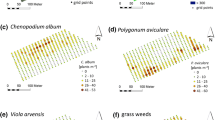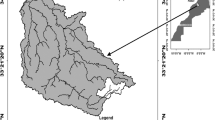Abstract
Research across an experimental site of 48.7 ha of Chernozem and Phaeozem determined magnetic susceptibility and soil indicators (organic carbon, nitrate and ammonium nitrogen, available phosphorus and potassium, and pH) for individual plots, each with an area of 1.5–2.0 ha. Based on magnetic susceptibility, soil heterogeneity was generalized for elementary geochemical landscapes, each with a particular NPK composition and pH. Magnetic susceptibility has potential for mapping agronomically important soil attributes; this might be a convenient way to implement the principles of precision farming.
Access this chapter
Tax calculation will be finalised at checkout
Purchases are for personal use only
Similar content being viewed by others
References
Alekseeva T, Z Sokolowska, M Hajnos and others 2009 Water stability of aggregates in subtropical and tropical soils (Georgia and China) and its relationships with the mineralogy and chemical properties. Eurasian Soil Science 42: 415–425. https://doi.org/10.1134/S1064229309040085.
Alifanov, V.M., I.M. Vagapov, L.A. Gugalinsky and others. 2010. Use of capappametry to identify elements of paleocryogenic microrelief. Bulletin of the Samara Scientific Centre of the Russian Academy of Sciences 12, 1, 4: 980–983 (Russian).
Baveye, P.C., and M. Laba. 2015. Moving away from the geostatistical lamp post: Why, where and how does the spatial heterogeneity of soil matter? Ecological Modelling 298: 24–38. https://doi.org/10.1016/j.ecolmodel.2014.03.018.
Bondar, K., I. Tsyupa, and A. Korol. 2015. Magnetic method of Zaporizhzhya soil pollution assessment: Ecological and geochemistry justification. Bulletin of Taras Shevchenko National University of Kyiv, Geology 4: 54–60. https://doi.org/10.17721/1728-2713.71.09 (Ukrainian).
Bukovsky, V.P., A.V. Sukhorada, O.V. Kruglov and others. 2008. On the role of pedomagnetic research in the geological survey of the crystalline basement. Bulletin of Taras Shevchenko National University of Kyiv, Geology 44: 37–40 (Ukrainian).
Dankoub, Z., S. Ayoubi, H. Khademi, and S.G. Lu. 2012. Spatial distribution of magnetic properties and selected heavy metals in calcareous soils as affected by land use in the Isfahan region, Central Iran. Pedosphere 22 (1): 33–47. https://doi.org/10.1016/S1002-0160(11)60189-6.
de Souza, B.A., J.J. Marques, J. La Scala and others. 2017. Prediction and mapping of soil attributes using diffuse reflectance spectroscopy and magnetic susceptibility. Soil Science Society of America Journal 81: 1450–1462. http://dx.doi.org/10.2136/sssaj2017.06.0206.
Evans, M., and F. Heller F. 2003. Environmental magnetism: principles and applications of enviromagnetics. San Diego CA: Academic Press.
Fontes, M.P., T.S. de Oliveira, L.M. da Costa, and A.A. Campos. 2000. Magnetic separation and evaluation of magnetization of Brazilian soils from different parent materials. Geoderma 96: 81–99. https://doi.org/10.1016/S0016-7061(00)00005-7.
Fraterrigo, J.M., M.G. Turner, S.M. Pearson, and P. Dixon. 2005. Effects of past land use on spatial heterogeneity of soil nutrients in southern Appalachian forests. Ecological Monographs 75 (2): 215–230. https://doi.org/10.1890/03-0475.
Gannon, J.P., K.J. McGuire, S.W. Bailey and others. 2017. Lateral water flux in the unsaturated zone: a mechanism for the formation of spatial soil heterogeneity in a headwater catchment. Hydrological Processes 31: 3568–3579. https://doi.org/10.1002/hyp.11279.
Gilliam, F.S. and D.A. Dick. 2010. Spatial heterogeneity of soil nutrients and plant species in herb-dominated communities of contrasting land use. Plant Ecology 209: 83–94. https://doi.org/10.1007/s11258-010-9725-x.
Glazovskaya, M.A. 2002. Geochemical foundations of typology and methods for the study of natural landscapes. Smolensk: Oikumena.
Gravuer, K., A. Eskelinen, J.B. Winbourne and S.P. Harrison. 2019. Vulnerability and resistance in the spatial heterogeneity of soil microbial communities under resource addition. PNAS 117 (13): 7263–7270. https://doi.org/10.1073/pnas.1908117117.
Guo, Q., T. Guo, Z. Ma and Z. Che. 2014. Seasonal performance and spatial heterogeneity of soil salt ions in a semiarid orchard of Northwest China. HortScience 49 (5): 653–661. https://doi.org/10.21273/HORTSCI.49.5.653.
IUSS Working Group WRB. 2015. World reference base for soil resources 2014, update 2015. World Soil Resources Report 106, Food and Agriculture Organization of the United Nations, Rome.
Jakšík, O., R. Kodešová, A. Kapička and others. 2016. Using magnetic susceptibility mapping for assessing soil degradation due to water erosion. Soil and Water Research 11: 105–113. https://doi.org/10.17221/233/2015-SWR.
Jiménez, C., J. Benavides, D.I. Ospina-Salazar and others. 2017. Relationship between physical properties and the magnetic susceptibility in two soils of Valle del Cauca. Revista de Ciencias Agricolas 34 (2): 33–45. https://doi.org/10.22267/rcia.173402.70.
Kassai, P., and I. Sisak. 2018. The role of geology in the spatial prediction of soil properties in the watershed of Lake Balaton, Hungary. Geologia Croatica 71 (1): 29–39. https://doi.org/10.4154/gc.2018.04.
Khomenko, R., K. Bondar and S. Popov. 2013. A new shallow multi-electrode installation for measuring electrical resistance. Bulletin of Taras Shevchenko National University of Kyiv. Geology 2 (61): 36–40. http://geolvisnyk.univ.kiev.ua/khomenko.pdf (Ukrainian).
Khristenko, A. 2017. Theoretical problems of improving agrochemical terminology, 141–148 in D.L. Dent and Y. Dmytruk (eds.) Soil science working for a living. Springer Nature, Cham. https://doi.org/10.1007/978-3-319-45417-7_12.
Klebanovich, N.V., A.L. Kindeev, A.A. Sazonov and others. 2019. Spatial inhomogeneity of soil structure and agrochemical indicators of the Soligorsk district. Land of Belarus 1: 39–48. https://elib.bsu.by/bitstream/123456789/240979/1/domas_a_c_prostranstvennaya_neodnorodnost_pochvennogo_pokrova_i_agrohimicheskih_pokazatelej_pochv_soligorskogo_rajona.pdf (Russian).
Kruglov, O.V., E.V. Panasenko, S.E. Zalavsky and others. 2019. Magnetic susceptibility of Chernozem of Kharkiv region and its diagnostic value. Bulletin of Agricultural Science 10, 799: 12–17. https://doi.org/10.31073/agrovisnyk201910-02 (Ukrainian).
Li, X.F., Z.B. Chen, H.B. Chen and Z.Q. Chen. 2011. Spatial distribution of soil nutrients and their response to land use in an eroded area of South China. Procedia Environmental Science 10: 14–19. https://doi.org/10.1016/j.proenv.2011.09.004.
Medvedev, V.V. 2015. Soil spatial heterogeneity and systems of agriculture. Agricultural Science and Practice 1: 50–59. http://nbuv.gov.ua/UJRN/asp_2015_1_8.
Menshov, O., O. Kruglov, S. Vyzhva and others. 2018. Magnetic methods for tracing soil erosion, Kharkiv Region, Ukraine. Studies in Geophysics and Geodesy 62: 681–696. https://doi.org/10.1007/s11200-018-0803-1 (Ukrainian).
Menshov, O., and A. Sukhorada. 2017. Fundamentals of the theory and methodology of soil geophysics: The first results of practical application. Bulletin of Taras Shevchenko National University of Kyiv, Geology 4 (79): 35–39. http://doi.org/10.17721/1728-2713.79.05 (Ukrainian).
Metwally, M.S., S.M. Shaddad, M. Liu and others. 2019. Soil properties spatial variability and delineation of site-specific management zones based on soil fertility using fuzzy clustering in a hilly field in Jianyang, Sichuan, China. Sustainability 11, 7084. https://doi.org/10.3390/su11247084.
Patton, N.R., K.A. Lohse, M.S. Seyfried and others. 2019. Topographic controls of soil organic carbon on soil-mantled landscapes. Scientific Reports 9: 6390. https://doi.org/10.1038/s41598-019-42556-5.
Peluco, R.G., J.J. Marques, D.S. Siqueira and others. 2013. Suscetibilidade magnetica do solo e estimaгo da capacidade de suporte a aplicacao de vinhaia. Pesquisa Agropecuária Brasileira 48: 661–672. doi:10.1590/S0100-204X2 01300 0600012 (Portuguese).
Robert, P.C. 1982. Evaluation of some remote sensing techniques for soil and crop management. PhD dissertation, University of Minnesota, St. Paul MN.
Robert, P.C., S. Smith, W. Thompson and others. 1990. Soil specific management, 54–55 in Research report on field research in soils. Minnesota Agricultural Expt Station Misc Pub 62. University of Minnesota, St. Paul, MN.
Samsonova, V.P. 2008. Spatial variability of soil properties: The example of sod-podzolic soils. URSS, Moscow. http://www.geokniga.org/bookfiles/geokniga-glazovskayaghosnovytipologiilandshaftov2002.pdf (Russian).
Santoso, N.A., M. Iqbal, G. Ekawati, and R. Firdaus R. 2019. Study of pH and magnetic susceptibility to fertility rate of agricultural soil around Institut Teknologi Sumatera, Lampung, Indonesia. IOP Conference Series: Earth and Environmental Science 258: 012001. https://doi.org/10.1088/1755-1315/258/1/012001.
Uzielli, M., S. Lacasse, F.. Nadim and K.K. Phoon. 2006. Soil variability analysis for geotechnical practice. 1653–752 in TS Tan and others (editors) Characterization and engineering properties of natural soils. https://doi.org/10.1201/noe0415426916.
Wang. H., Y. Huo, L. Zeng and others. 2008. A 42-yr soil erosion record inferred from mineral magnetism of reservoir sediments in a small carbonate-rock catchment, Guizhou Plateau, southwest China. Journal of Paleolimnology 40: 897–921. https://doi.org/10.1007/s10933-008-9206-6.
Xi, N., C. Zhang. and J.M. Bloor. 2017. Species richness alters spatial nutrient heterogeneity effects on above-ground plant biomass. Biology Letters 13 (12): 20170510. https://doi.org/10.1098/rsbl.2017.0510.
Yu, H., N. Shen, D. Yu, and C. Liu C. 2019. Effect of temporal heterogeneity of water supply and spatial heterogeneity of soil nutrients on the growth and intraspecific competition of Bolboschoenus yagara depend on plant density. Frontiers in Plant Science 9, 1987. https://doi.org/10.3389/fps.2018.01987.
Acknowledgements
The authors are indebted to Lydia Burlakova and Olga Nazarenko, technical staff of the ON Sokolovsky Institute for Soil Science and Agrochemistry Research, for their help in analytical research.
Author information
Authors and Affiliations
Corresponding author
Editor information
Editors and Affiliations
Rights and permissions
Copyright information
© 2021 The Author(s), under exclusive license to Springer Nature Switzerland AG
About this chapter
Cite this chapter
Miroshnychenko, M., Kruglov, O., Nazarok, P., Kovalenko, S. (2021). Identification of the Structure of Soil Cover by Magnetic Susceptibility. In: Dmytruk, Y., Dent, D. (eds) Soils Under Stress. Springer, Cham. https://doi.org/10.1007/978-3-030-68394-8_6
Download citation
DOI: https://doi.org/10.1007/978-3-030-68394-8_6
Published:
Publisher Name: Springer, Cham
Print ISBN: 978-3-030-68393-1
Online ISBN: 978-3-030-68394-8
eBook Packages: Earth and Environmental ScienceEarth and Environmental Science (R0)




